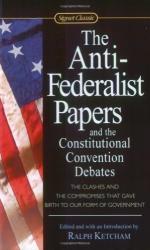
|
| Name: _________________________ | Period: ___________________ |
This test consists of 15 multiple choice questions and 5 short answer questions.
Multiple Choice Questions
1. How did the South want the Constitution to regulate trade?
(a) The South wanted the Constitution to let Congress set tariffs with a simple majority vote.
(b) The South wanted the Constitution to keep tariffs low indefinitely.
(c) The South wanted the Constitution not to regulate trade at all.
(d) The South wanted the Constitution to keep Congress from restricting trade.
2. What did James Madison support?
(a) A system of checks and balances.
(b) A government of businesses.
(c) A strong federal government.
(d) Strong state governments.
3. What happened to the motion not to give government officers salaries?
(a) It was killed in committee.
(b) It was rejected as too aristocratic.
(c) It was rejected as impractical.
(d) It was tabled to be voted on later.
4. Where on the political spectrum were Alexander Hamilton's opinions?
(a) Closer to anarchy than democracy.
(b) Closer to republicanism than democracy.
(c) Closer to democracy than republicanism.
(d) Closer to monarchy than democracy.
5. What did Mr. Paterson argue about the New Jersey Plan?
(a) That it made the federal government too independent.
(b) That it diminished the power of the states.
(c) That it did not protect the states enough.
(d) That it did not give the executive too much power.
6. What were the delegates debating in Chapter 3?
(a) The election of the House of Representatives.
(b) The election of the President.
(c) The appointment of judges.
(d) The election of Senators.
7. Who was particularly concerned about the Virginia Plan?
(a) Southern states.
(b) Small states.
(c) Populous states.
(d) Large states.
8. What were opponents of the resolution that was ultimately adopted afraid of?
(a) That the states would gain too much independence.
(b) That the federal government would become too powerful.
(c) That foreign countries would be able to divide and conquer.
(d) That trade would be stifled.
9. Which form of government includes a king whose powers are limited by a statement of the laws?
(a) Empire.
(b) Constitutional monarchy.
(c) Representative democracy.
(d) Republic.
10. Which form of government includes direct voting by the people?
(a) Republic.
(b) Constitutional monarchy.
(c) Representative democracy.
(d) Oligarchy.
11. What did William Paterson offer the convention?
(a) The Missouri Compromise.
(b) The Virginia Plan.
(c) The New Jersey Plan.
(d) The Great Compromise.
12. What must the government use its power to protect the people from, in James Madison's opinion?
(a) The government itself.
(b) Big businesses.
(c) Foreign influence.
(d) Corruption.
13. Which form of government includes a representative government without hereditary privilege?
(a) Constitutional monarchy.
(b) Republic.
(c) Representative democracy.
(d) Oligarchy.
14. Which constituents did Dr. Johnson want to placate with the plan he advocated?
(a) Small states.
(b) Foreign diplomats.
(c) Federalists.
(d) The upper classes.
15. What thoughts did Mr. Wilson express at the convention?
(a) Popular election will lead to a tyranny of the masses.
(b) Popular election will give people confidence in the government.
(c) Popular election will debase public discourse.
(d) Popular election will allow the people to mislead each other.
Short Answer Questions
1. What did Randolph argue at the convention?
2. Why did delegates argue for a judicial veto power?
3. What did Alexander Hamilton propose in his speech?
4. What was the benefit of adopting the resolution that was ultimately adopted?
5. What reason did Mr. Mason give for the view he presented at the convention?
|
This section contains 629 words (approx. 3 pages at 300 words per page) |

|




